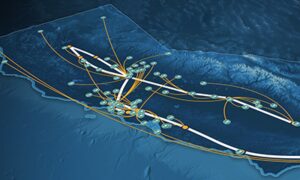- About
- Network
- Community
- Initiatives
- News
- Events
- Blog
- Publications

CENIC Membership Enables San Joaquin Valley Library System’s Wi-Fi Revolution
Categories Libraries Equity & Access
Aaron Lusk began his career with the San Joaquin Valley Library System (SJVLS) at the time of frame relay and T1s. He has seen firsthand how far the system has come in the last decade thanks to its participation in the Corporation for Education Network Initiatives in California (CENIC). “Ten years later, we have 105 public libraries in the San Joaquin Valley Library System connected to CENIC’s California Research and Education Network (CalREN) behind ten main libraries,” said Lusk, SJVLS network systems engineer.
High-bandwidth connectivity is now ubiquitous in the SJVLS territory, with most branches at 100 Mbps or 1 Gbps and main libraries at 1 or 10 Gbps—faster connectivity than most houses around the library in some communities.
A large part of this improvement follows from the economies of scale offered by participation in the CENIC membership of over 12,000 institutions in California. Thanks to the aggregation of demand and cost savings CENIC makes possible on behalf of its members, SJVLS no longer needs to bid all of its network services through one provider but can allow CENIC to manage multiple relationships with a variety of circuit providers. This enables SJVLS to avoid the constraints of using a single provider, such as limited service options, lower bandwidth, and considerably greater cost.
This has also enabled a vast improvement in the Wi-Fi services that the SJVLS offers to its patrons and staff—and for far less cost.
SJVLS is a library consortium spread throughout seven counties, including two city libraries and a special district, and comprises nearly 10% of the libraries in California. The consortium’s 26,000-square-mile territory is enormous and encompasses two very large metro areas (Bakersfield and Fresno), as well as many remote small farming communities and national park land. “For years,” explained Lusk, “we had to tell people we couldn’t do Wi-Fi because we didn’t have the bandwidth. The locations that were able to offer Wi-Fi did so at great cost, and the services did not offer sufficient control, coverage, or support. Typically, there were only one or two access points in a single building, and issues could take days to be resolved.”

CalREN Empowers a Wi-Fi Renaissance for San Joaquin Valley Libraries
Thankfully, the CENIC member benefits described above—improved bandwidth and better vendor management at far less cost—have made possible the SJVLS’s recent large-scale deployment of indoor and outdoor Wi-Fi at its many locations. In terms of cold numbers, this translates to 30,000 unique wireless devices connecting to SJVLS Wi-Fi access points each month. “Since the beginning of 2025, we’ve expanded outdoor Wi-Fi and have been able to service 100,000 individual wireless devices for our patrons, 32,000 of which were serviced in the month of May alone—and all of this traffic is flowing over CalREN to other libraries, other CENIC members, and beyond to the global Internet,” noted Lusk.
Lusk states that foot traffic at each location has also increased as patrons make use of the Wi-Fi offered at their local libraries. Moreover, since most patrons bring their own devices with them to study, search for employment, or even run small businesses, this has changed the kinds of public computers that libraries provide.
Wi-Fi has also allowed branches to continue providing services to their communities after hours. While libraries choose to stop offering Wi-Fi past 10 pm to avoid creating an “attractive nuisance,” even that provides an incredibly useful service beyond a site’s operating hours, especially if that site is only physically open for a few days a week. Moreover, patrons can sit in their cars and connect to the outdoor Wi-Fi for access to no-cost, password-free connectivity, thanks to the completion of the SJVLS Wi-Fi project.
In fact, in some locations, Lusk has seen that outdoor access points are busier than indoor ones. For example, outdoor Wi-Fi access points at the Wawona Bassett Memorial Library located inside Yosemite National Park see five times as much usage as indoor access points.

Procurement, Contracting, and Other Business Matters
In addition to improved bandwidth and service for patrons and staff, other unforeseen benefits have become evident with the completion of the SJVLS’s Wi-Fi project.
Support has greatly improved from earlier days now that all the system’s Wi-Fi access points are centrally controlled through Meraki (a Cisco product), and management and support are all cloud-based. “On one screen, I can see all our wireless installs,” Lusk explains. “I can also delegate access to this information to each location’s local techs so they can see their part of the network. Whenever issues arise, instead of calling an outside vendor, I can see everything. Existing staff are the Tier 2 support for the whole system; we’re almost our own NOC.”
Cost benefits go beyond the far superior and more reliable connectivity to CalREN and beyond provided by CENIC. The cost of Wi-Fi access point installations would have been much harder to bear without the cost savings associated with CENIC membership, and as Lusk stated above, the Wi-Fi service is managed with existing staff time. This results in savings of several hundred thousand dollars a year for Fresno County Public Library, with similar savings in other locations—and for vastly improved connectivity and service to patrons.
Infrastructure-related headaches are also familiar to libraries, and the SJVLS is no exception, with locations including strip malls, mid-century former bomb shelters, cabins, and shared buildings. Through the recently completed Wi-Fi project, they were able to overcome these challenges and achieve improved reliability by cabling access points (weather-sealed for the outdoor ones) directly into the network rather than simply meshing them together.
“We’ve come a long way thanks to our participation in CENIC,” Lusk concludes. “The level of connectivity and cost savings we now enjoy all the way out to individual branches is well beyond what we started with. We’re delighted that it can support this level of Wi-Fi use and look forward to what will become possible in the future.”
If you’re curious about other projects relating to any CENIC member segment—not only California’s public libraries—be sure to keep an eye on our blog and save the date for our next Biennial Conference taking place in Monterey from March 29–April 1, 2026.
Related blog posts
CENIC Members Bolster the Economy by Expanding Digital Literacy in California
Members of CENIC are working to improve digital literacy by supporting initiatives aimed at creating digital access for more Californians and by creating programs to enhance digital literacy once those people have been connected.
Ventura County Library Capitalizes on CENIC Membership to Provide eduroam Connectivity to Student and Faculty Patrons
By becoming eduroam Hotspot Operators, Ventura County Library and its branches offer the extremely valuable service of eduroam connectivity to its student and faculty residents.


